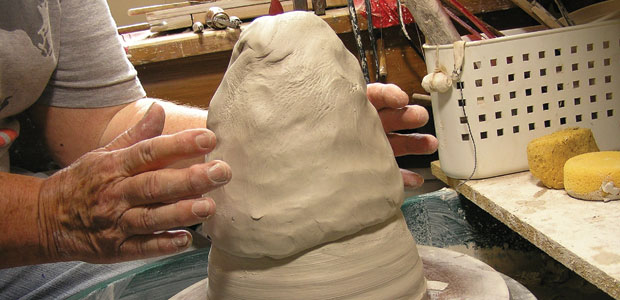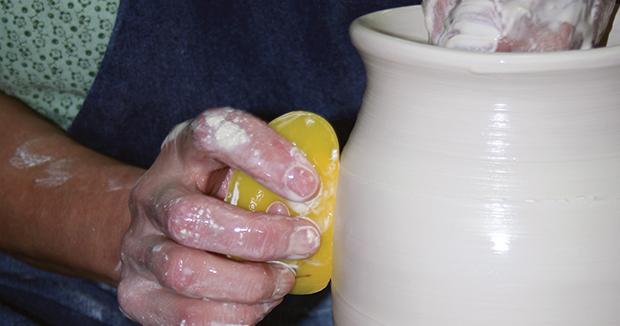Wedging And Centering Large Amounts of Clay

Centering large amounts of clay is something that I put off for a long time. I just didn’t think my wrists could handle it. But I have learned over the years that learning how to center lots of clay doesn’t require brawn. It requires brains!
In this post, Claire O’Conner has a number of great tips for those learning how to center clay on the pottery wheel–especially if you want to center a lot of clay. She also gives advice on wedging clay in large amounts.
Selecting and Wedging Clay for Centering
Experiment until you find a clay body that works for you. If you’re throwing large pots, try using softer clay and throw it dry (or with less water) to avoid degenerating it to mush.
Wedge using the weight and strength of your whole body on a wedging table of the proper height. Ideally, the table height should be equal to the distance between fingertips and floor (figure 1). If that’s not available, raise your body using an aerobics riser or wide, heavy cinder block. Or you can move down to a clean cement floor and wedge as usual. Now that you’re down here, or up there, you’re ready to wedge. Bernard Leach (A Potter’s Book) was confident potters could wedge up to 30 pounds of clay. I say 20 pounds is more manageable. The hardest part is getting the spiral or ram’s head started. So start smaller, with about 5 pounds, and periodically add in 1–2 pound slices (figure 2).
Wheel Throwing Posture
Posture at the wheel is important. Sitting at the level of the wheel head (or slightly higher), as close to the wheel as you can get, with a straight back, and arms locked on your body is healthy, safe, and makes efficient use of bone, muscle, and gravity. You can also prop or mount a mirror in front of you to avoid resorting to the hunched-over side view to see the lower profile of your pot. Some (including potters, their mothers, and their health-care providers) swear that throwing standing up or using an alternative sitting position like a raised seat and/or raised wheel is best. If there are no extenders available for your wheel, cinder blocks or a platform built to your needs will do the trick. Some who use a stand up pottery wheel find that positioning their back against a wall provides a brace and more strength. Standing on a foam rubber floor mat minimizes stresses on legs and feet.



Centering Large Amounts of Clay
Whether sitting or standing, it’s important to learn how to center clay smartly. Many people firmly slap a revolving lump of clay to adhere it to the wheel head or bat. With several extra rotations and firm, open-handed slaps (always aimed in and down) you can also accomplish a lot of the early centering (figure 3). Your next step is to press firmly with your fingers on the base of the slowly rotating lump of clay (figure 4). This helps fix the clay onto the wheel head and, with several extra rotations, can do some of the centering. The final centering comes next. If you’re standing, brace your elbows against your abdomen. If you’re sitting, place your left foot up on a brick to keep your thigh parallel to the wheel head and high enough to brace your elbow against it. Brace your right arm against your right leg, and you’re ready to center. It’s important to move your body as a unit so that you have more leverage over the clay.
Press in on both sides to move your clay into a cone shape (see figure 6), and lean in, using your body weight to press the cone down. This process of creating and then flattening a cone shape aligns the clay in a spiral shape, and makes it more workable.
At this point you can either begin throwing or you can go bigger by adding a cone-shaped mass to the top of this first piece of centered clay, slapping it into shape and closer to centered (figure 5). After securely connecting the two, press in from both sides to shape the whole mass into a cone (figure 6), then press down on it to compress, widen, flatten, and finish the centering for the whole mass.



Centering the base of a large mound of clay is hardest part of learning how to center clay in large amounts. So, without shame or embarrassment, grip your wooden potter’s knife firmly in both hands with the tapered edge held parallel to the clay and positioned slightly above the uncentered section. With the wheel spinning, slowly move the tool down into the uncentered clay, making a small groove, and follow the groove to the wheel head to shave off the bumpy stuff. With your mass now centered, flattened, and broadened to the intended final dimension of the base, create a center hole using your thumbs or two fingers.
Despite what you see on some YouTube videos, always keep your hands together when opening the floor of the pot after creating the center hole and whenever possible as you are pulling up the walls while throwing. Remember, the parts of smart potters’ bodies work as coordinated units. I find the best opening position is both hands at 6 o’clock. In most cases, my left hand is relatively passive with my right hand doing most of the pressing and pulling. If you are left handed and your wheel spins clockwise, reverse this order.
Claire O’Connor teaches pottery for children, adults, and senior adults. She has graduate and undergraduate education in anthropology, educational psychology/adult education, and ceramics. She currently has a studio at the Northern Clay Center in Minneapolis, Minnesota.







